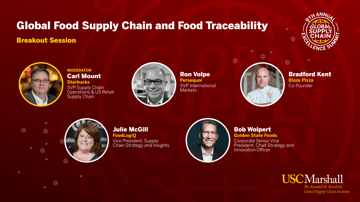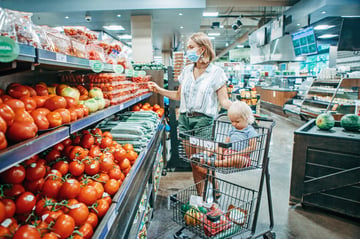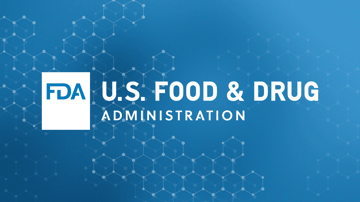FoodLogiQ’s Chief Marketing and Strategy Officer, Katy Jones, examines key insights from the 2019 Wall Street Journal Global Food Forum including the changing consumer, how traceability is gaining momentum, and why food waste is a focus at the farm-level.
Speakers at yesterday’s WSJ Global Food Forum set the stage for valuable ongoing discussions about the risks and opportunities driving the future of global food business. The event took place in New York City, bringing together leaders from agribusiness, technology, economics, and government. The program tackled numerous issues facing the food industry—from the impact alternative meats and startups are having on established markets, to the role data, traceability, and automation will play in the changing landscape of agricultural labor and supply chain transparency.
Throughout the interviews, one central theme was clear: building a better customer experience is at the heart of building a stronger food business, and customers are asking for more transparency, choices, and sustainability. Discussions included industry thought leaders such as the FDA’s Deputy Commissioner for Food Policy and Response Frank Yiannas, President of McDonald's USA Chris Kempczinski, and sweetgreen Co-Founder/CEO Jonathan Neman. Read a roundup of key takeaways below:
It All Starts with the Consumer
An overarching theme of the conference was developing food solutions and business strategy around customer sentiment. One trend in consumer packaged goods, noted by Dirk Van De Put, Chairman and CEO of Mondelēz International, is an increase in “permissible snacking.” Consumers are looking for a responsible way to eat on the go or between meals. With 20 percent of snack sales dollars going toward health and wellness snacks, CPG brands need to diversify product offerings and create smaller packaging that gives consumers more control over portion sizes.
Sweetgreen CEO Jonathan Neman covered his own company’s innovation in bringing consumers more choice, discussing the lessons food stakeholders can learn from next-gen content providers like Netflix. They see food, he explained, as a type of content that can benefit from a marketplace approach—customers should be able to access that content when they want it and where they want it. Ultimately, it all comes down to giving the consumers better models for food consumption. Neman noted, “I do believe the world needs a different kind of food brand. We’re trying to create a food brand that sources food in a different kind of way.”
Sanjeev Krishnan of S2G Ventures also stressed the importance of investment in the high margin products and vendors typically found on the perimeter of grocery stores; consumers are looking to brands to bring higher quality and diversity to their shopping experience.
Not to be Ignored: Traceability through Digitalization
Multiple speakers were also bullish on the digitization of the supply chain. The trend toward traceability is building momentum in the food industry, and Silicon Valley is taking note.
Stronger consumer interest in their food consumption is driving the need for stronger investment in supply chain transparency. As the Food Safety Modernization Act continues to roll out, companies should take the essential first steps needed to address traceability. FoodLogiQ’s own supply chain management and traceability solutions are designed to help companies make this transition.
The conference included two sessions on the “view from Washington”, covering how regulators should respond to emerging food safety threats, as well as the impact that tariffs will have on food businesses. Frank Yiannas of the FDA discussed the limitations of prevention in curbing incidents of food borne illness, a central concern driving the FDA’s New Era of Smarter Food Safety campaign. FoodLogiQ will be attending the FDA’s public meeting on this initiative, slated for October 21, 2019 at the Hilton Washington, D.C./Rockville Hotel & Executive Meeting Center in Rockville, Maryland.
The Future of Food Efficiency
The status of food waste, agricultural efficiency, and labor were also central topics at the forum, with automation posing both opportunities and risks in each area. While a bar of “zero food waste” may not be realistic, there are many pain points that need to be addressed. Automation and robotics can be considered as supplemental tools, taking on roles that are complementary to jobs that rely on human oversight.
Cargill Chief Sustainability Officer Ruth Kimmelshue shared that most food waste happens at the farm. She further explained that farmers are a key stakeholder in the transformation of global food and need to be included in future legislation and decision-making. There are plenty of action items brands farther down the supply chain can take on, as well. One key way CPG brands and restaurants can offset food waste is by investing in shelf life extension and innovations in alternative proteins. Reducing waste and increasing efficiency is an imperative shared across the industry.
The Future Starts Now
The event proved to be an exciting view into the future of global food, but also outlined the massive amount of work and coordination that lies ahead. At FoodLogiQ, we believe that better supplier management and supply chain transparency are essential for brands that don’t want to get left behind. Request a demo to learn how we can support your business and help you keep pace with an evolving industry.
Other posts you might be interested in
View All Posts
Trustwell News
4 min read
| October 22, 2021
FoodLogiQ Talks Traceability at the Global Supply Chain Excellence Summit
Read More
6 min read
| May 4, 2023
Five Strategies to Stay on Top of Consumer Food Trends
Read More
Traceability
6 min read
| January 29, 2021

